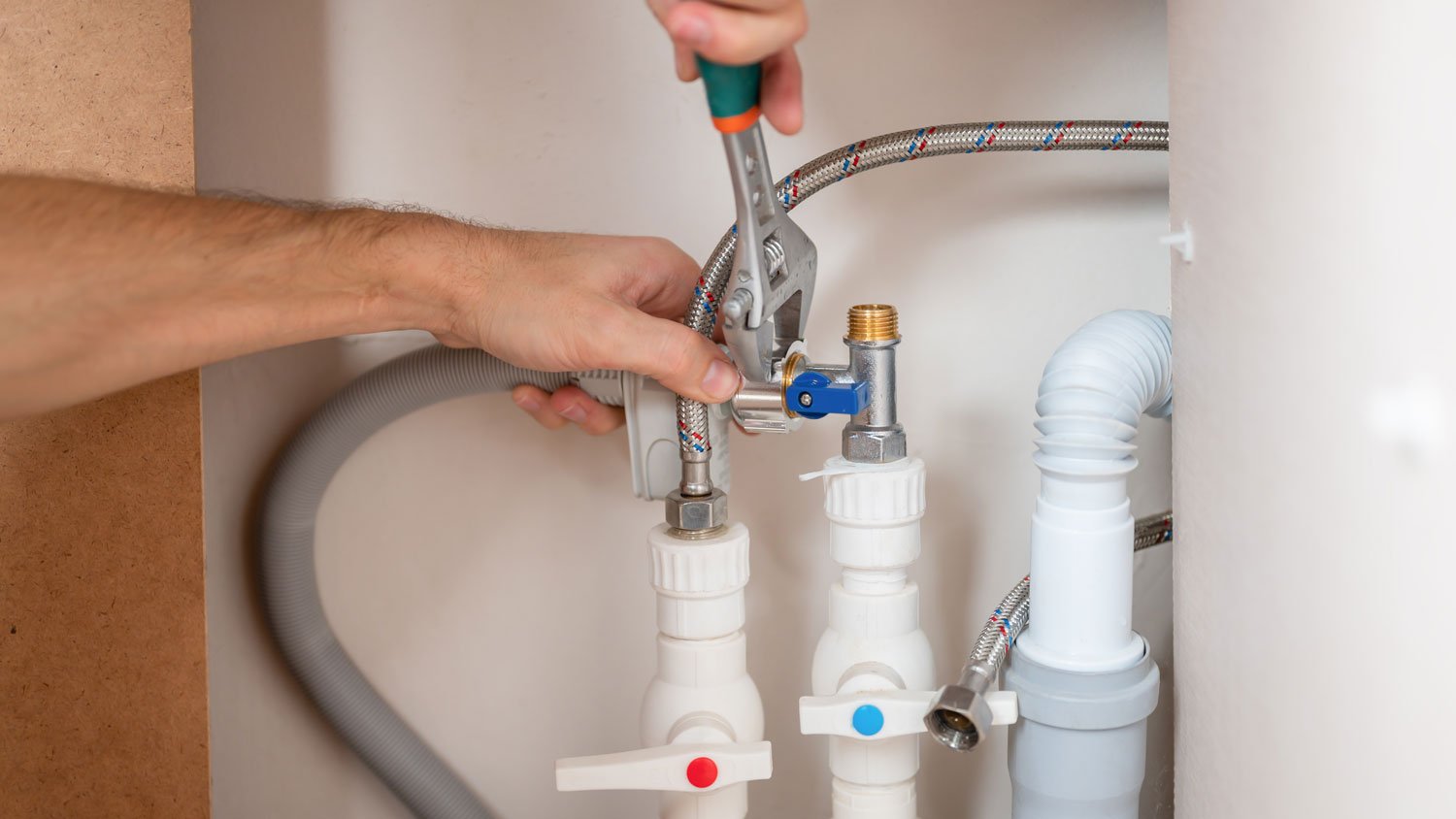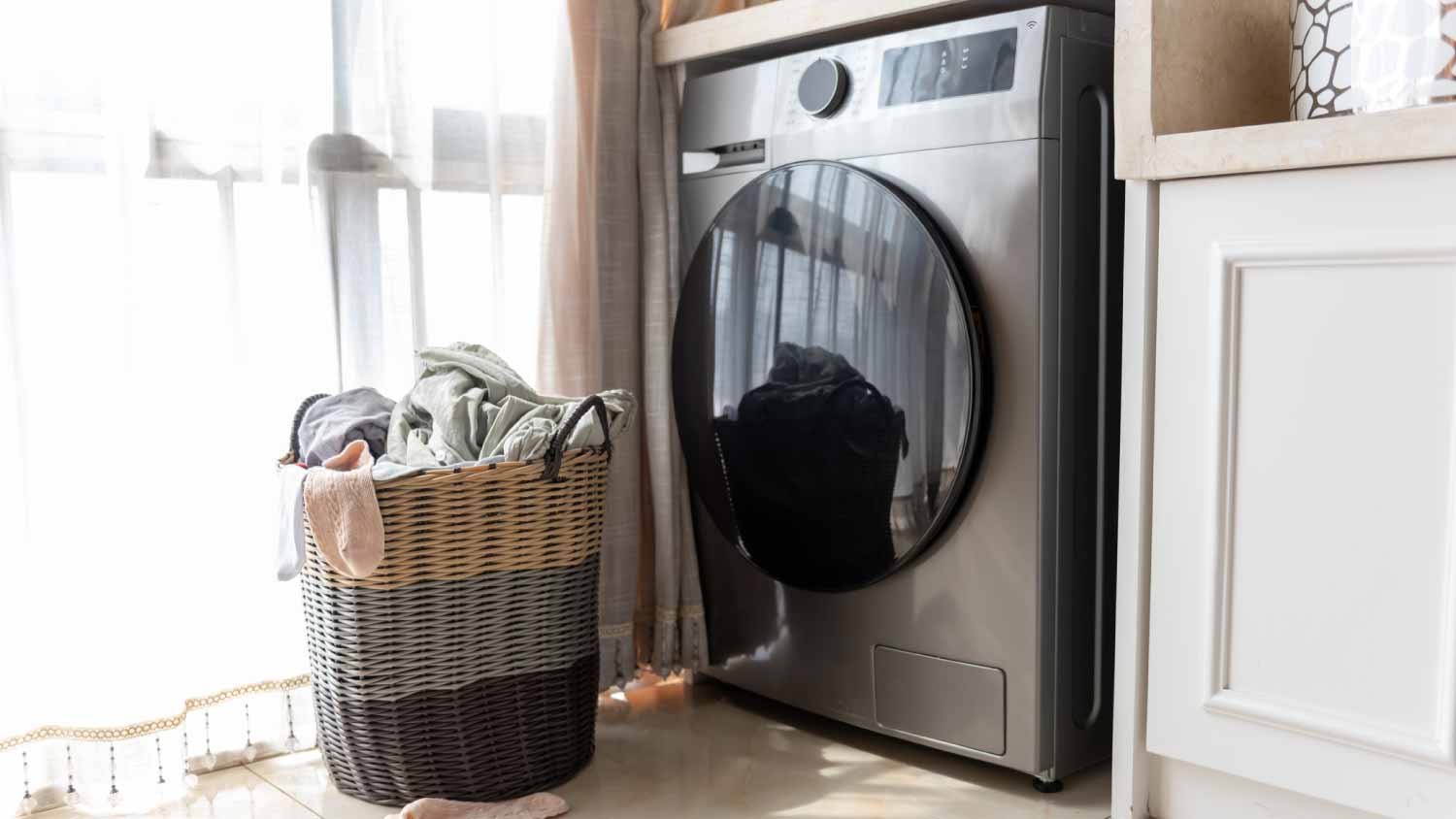How to Remove a Dishwasher in 8 Simple Steps
This is one of those projects that’s easier with a second set of hands


- Screwdriver (most often a Phillips-Head screwdriver)
- Bucket
- Hand wrench
- Utility knife
- Dolly
- Dishwasher
- Towels
- Paper towels to stuff dishwasher hoses
Removing a dishwasher is something that most people rarely think about. It typically lasts a long time and, unless it’s truly broken, doesn’t usually require removal. If there is irreparable damage or you simply want to upgrade, removing your dishwasher on your own can save you quite a bit of money. Before you pull out your screwdriver and get started, remember that dishwashers are heavy, so make sure you have the strength to handle this DIY project safely.
Prepping to Remove a Dishwasher
You’ve gathered your tools and supplies, and are ready to say goodbye to your trusty—or not-so-trusty—dishwasher. There are a few things to consider before starting the removal. Dishwashers are a heavy appliance. Really heavy. Most weigh 100 to 150 pounds, so stop right here if you have any injuries or are unsure about the weight of your dishwasher.
A dolly can make it easier to glide the dishwasher out of your home, but if you're concerned about injuring yourself, you may be better off hiring someone to do the job for you. Should you decide to DIY, make sure you have a strong friend to help you with the heavy lifting.
Many appliance projects, whether it’s installing, repairing, or cleaning, will involve moving heavy objects. In order to avoid injury, homeowners should always get assistance from at least one other person when moving an appliance.
Use a heavy-duty tarp to protect your floor from potential water damage. The tarp will also prevent your floor from getting scuffed or damaged by the dolly or dishwasher.
How to Uninstall a Dishwasher
When removing a dishwasher, think safety first. That means disconnecting the power and water supplies before you touch the appliance. It also means having someone help you with the heavy lifting.

Once you’re prepped, follow these eight steps to uninstall a dishwasher.
Turn Off the Power
A crucial first step is turning off the power to your dishwasher. You can locate the switch in your power breaker box. Because of the wattage dishwashers draw, they usually have their own breaker. If you are unable to locate it or are unsure which one it is, flip off the power to the entire kitchen. There may be a leak that you cannot see, and removing electrical appliances with water present could be dangerous.
Turn Off the Water Supply
Be sure to turn the water to the dishwasher off, or when you disconnect the hoses and drain tubes, you may create an enormous mess. If you have access to the back of the dishwasher, the shut-off valve can sometimes be close to the machines.
More often than not, you’ll need to look under your kitchen sink and find the hot water line that leads to the dishwasher. There should also be a drain line that you will need to disconnect. Use a bucket to catch any water that leaks. Make sure the water is off before continuing.
Remove the Floor Panel
At the base of the dishwasher is a floor panel, or toe kick, that covers up the area where the water supply line and drain hose live. You'll need to remove the panel to get access to the supply line and drain hose.
To do that, get down on your hands and knees and peer underneath the dishwasher door, just above the floor panel. You should see screws, which attach the panel to the appliance. Loosen those screws, then gently remove the panel from the front of the appliance.
Disconnect the Water Supply Line
The water supply line connects to the dishwasher and to a water pipe, usually in your under-sink cabinet. Use a wrench to remove the water supply line from the dishwasher, then repeat the process to disconnect the supply line from the pipe.
Disconnect the Drain Hose
Next, remove the drain hose. One end of the hose may be connected to your sink's garbage disposal or the sink itself. If you live in an area that requires air gaps, the drain hose may connect to the sink or the underside of your countertop. In either case, remove the clips that connect one end of the hose.
Remove Screws and Mounting Brackets
 Photo: brizmaker / iStock / Getty Images Plus / Getty Images
Photo: brizmaker / iStock / Getty Images Plus / Getty ImagesNext, open the dishwasher door. You will see screws and mounting brackets that secure the dishwasher in its space. Remove the screws and, if you can, the mounting brackets. If the brackets are strongly affixed to the dishwasher, you do not have to remove them, but give them a jiggle with your hand or your screwdriver to loosen them. This will make the removal a little easier, as buildup can sometimes cause them to stick.
Lower the Dishwasher
Most dishwashers have legs on the bottom. Usually, these are simple metal or plastic screws and are used to level the dishwasher when it’s being installed. If you can access the legs, unscrew them so that the dishwasher is as close to the ground as possible. This will make removal much easier as it allows you more space to tip and turn the dishwasher. Those installing dishwashers will have to measure their dishwasher to make sure it fits the existing space.
Place the Dolly and Remove the Dishwasher
It comes as no surprise that the large cubed appliance is heavy, so let a dolly do the work for you. Slide it under the dishwasher and lift it just enough to get it off the ground. Then, simply pull the dishwasher out from its cutout and wheel it outside or into a truck or van.
You may experience minor leakage when the dishwasher is removed. You can use your towels to clean any spills. If there is more water in the hose line than anticipated, you can plug the hose using either one of your towels or paper towels.
DIY vs. Hiring a Pro to Remove a Dishwasher
If you have the physical strength and follow the steps above, you can easily remove your dishwasher without hiring a pro.
If you do hire a professional to remove your dishwasher, the good news is that your cost should be relatively low–especially compared to other household projects. Experienced local dishwasher repair pros or an appliance removal company near you should be able to handle the removal in about one hour, costing around $100 in labor.
If you’re getting rid of your dishwasher, make sure you ask about dumpster or appliance disposal fees. In most cities, you can’t put a dishwasher out for garbage collection.
Frequently Asked Questions
How long it takes to remove a dishwasher depends on how quickly you can work and the positioning of the appliance. In most cases, you can expect to remove a dishwasher in one to two hours. If the connections are older, you’ll need to use a bit more elbow grease to loosen them. This can make the process a bit longer.
When it comes to what you should do with old appliances, you have several options. If the dishwasher is still in good condition, you can list it for sale on an online marketplace. For an older or broken appliance, your best option is to recycle it. Your municipality may offer appliance recycling, or you may need to contact a junk hauler to pick it up and bring it to a facility.
If the dishwasher is in working condition, start and run a complete cycle with nothing inside. Let it drain and sit overnight before removing the hoses. In theory, it should effectively drain. You may find residual water in the hoses, but you can plug them. If the dishwasher breaks down midcycle it can sometimes be full of water. You’ll need to manually remove the water with a plastic cup before removing the dishwasher.





- Appliance Repair Companies
- Washing Machine Repair
- Dryer Repair
- Refrigerator Repair
- Dishwasher Repair
- Oven Repair
- Wood & Pellet Stove Repair
- Freezer Repair Services
- Wood Stove Services
- Gas Stove Repair
- Emergency Appliance Repair Companies
- Ice Maker Repair
- Gas Appliance Repair
- GE Appliance Repair
- GE Refrigerator Repair
- GE Dryer Repair
- GE Dishwasher Repair
- GE Washing Machine Repair
- Samsung Appliance Repair
- Samsung Refrigerator Repair
- Samsung Dryer Repair
- Samsung Washer Repair
- Samsung Dishwasher Repair
- Samsung Oven Repair
- Whirlpool Repair
- Whirlpool Refrigerator Repair
- Whirlpool Washer Repair
- Whirlpool Dryer Repair
- Whirlpool Oven Repair
- Maytag Appliance Repair
- Maytag Refrigerator Repair
- Maytag Washer Repair
- Maytag Dryer Repair
- Maytag Dishwasher Repair
- Kitchenaid Appliance Repair
- Kitchenaid Oven Repair
- Kitchenaid Refrigerator Repair
- Kenmore Appliance Repair
- Kenmore Dishwasher Repair
- Kenmore Washer Repair
- Kenmore Dryer Repair
- LG Refrigerator Repair
- Bosch Appliance Repair
- Kenmore Refrigerator Repair
- LG Appliance Repair Services
- GE Microwave Repair
- Electrolux Appliance Repair
- Electrolux Washer Repair
- Kitchenaid Dishwasher Repair Services
- Wood Stove Inspection
- Dishwasher Installation
- Trash Compactor Repair











